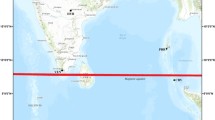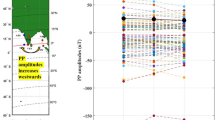Abstract
Ground and space-based geomagnetic data were used in the investigation of the longitudinal, seasonal and lunar phase dependence of the equatorial counter electrojet (CEJ) occurrence in the Peruvian, Brazilian, African, Indian and Philippine sectors during geomagnetically quiet days from the solar cycle 24 (2008 to 2018). We found that CEJ events occur more frequently during the morning (MCEJ) than in the afternoon (ACEJ). The highest MCEJ and ACEJ occurrence rates were observed for the Brazilian sector. Distinct seasonal dependence was found for each longitudinal sector under investigation. The lunar phase dependence was determined for the first time for the Philippine sector (longitude 125°E), and it was shown to be less pronounced than in the Peruvian, Brazilian and African sectors. We demonstrate that differences in CEJ rates derived from ground-based and satellite data can arise from the longitudinal separation between low-latitude and equatorial stations that are used to determine the signal and its consequent time delay in their sunrise/sunset times at ionospheric heights.
Similar content being viewed by others
References
Alken P. and Maus S., 2007. Spatio-temporal characterization of the equatorial electrojet from CHAMP, Ørsted, and SAC-C satellite magnetic measurements. J. Geophys. Res.-Space Phys., 112, A09305, DOI: https://doi.org/10.1029/2007JA012524.
Alken P., Chulliat A. and Maus S., 2013. Longitudinal and seasonal structure of the ionospheric equatorial electric field. J. Geophys. Res.-Space Phys., 118, 1298–1305, DOI: https://doi.org/10.1029/2012JA018314
Alken P., Maus S., Vigneron P., Sirol O. and Hulot G., 2013. Swarm SCARF equatorial electric field inversion chain. Earth Planets Space, 65, 1309–1317, DOI: https://doi.org/10.5047/eps.2013.09.008.
Alken P., Maus S., Chulliat A., Vigneron P., Sirol O. and Hulot G., 2015. Swarm equatorial electric field chain: First results. Geophys. Res. Lett., 42, 673–680, DOI: https://doi.org/10.1002/2014GL062658.
Archana R.K., Chandrasekhar N.P., Arora K. and Nagarajan N., 2018. Constraints on scale lengths of equatorial electrojet and counter electrojet phenomena from the Indian sector. J. Geophys. Res.-Space Phys., 123, 6821–6835, DOI: https://doi.org/10.1029/2018JA025213.
Chapman S., 1951. The equatorial electrojet as detected from the abnormal electric current distribution about Huancayo, Peru and elsewhere. Arch. Meteorol. Geophys. Bioklimatol. A, 4, 368–390.
Chapman S. and Bartels J., 1940. Geomagnetism. Oxford University Press London, U.K.
Chulliat A., Matzka J., Masson A. and Milan S., 2016. Key ground-based and space-based assets to disentangle magnetic field sources in the Earth’s environment. Space Sci. Rev., 206, 123–156, DOI: https://doi.org/10.1007/s11214-016-0291-y.
Courtillot V. and Le Mouël J.-L., 2007. The study of Earth’s magnetism (1269–1950): A foundation by Peregrinus and subsequent development of geomagnetism and paleomagnetism. Rev. Geophys., 45, RG3008, DOI: https://doi.org/10.1029/2006RG000198.
Doumouya V., Vassal J., Cohen Y., Fambitakoye O. and Menvielle M., 1998. Equatorial electrojet at African longitudes: first results from magnetic measurements. Ann. Geophys., 16, 658–676.
Efron B., 1981. Nonparametric estimates of standard error: The jackknife, the bootstrap, and other methods. Biometrika, 68, 589–599.
England S.L., Maus S., Immel T.J. and Mende S.B., 2006. Longitudinal variation of the E region electric fields caused by atmospheric tides. Geophys. Res. Lett., 33, L21105, DOI: https://doi.org/10.1029/2006GL027465
Forbes J.M., 1981. The equatorial electrojet. Rev. Geophys., 19, 469–504.
Friis-Christensen E., Lühr H. and Hulot G., 2006. Swarm: A constellation to study the Earth’s magnetic field. Earth Planets Space, 58, 351–358.
Friis-Christensen E., Lühr H., Knudsen D. and Haagmans R., 2008. Swarm — An Earth observation mission investigating geospace. Adv. Space Res., 41, 210–216, DOI: https://doi.org/10.1016/j.asr.2006.10.008.
Gouin P., 1962. Reversal of the magnetic daily variation at Addis Ababa. Nature, 193, 1145–1146.
Gouin P. and Mayaud P.N., 1967. A propos de lexistence possible d’un “contre-electrojet” aux latitudes magnetiques equatoriales. Ann. Géophys., 23, 41–47.
INTERMAGNET Operations Committee, 2011. INTERMAGNET Technical Reference Manual V4.5. Natural Resources Canada, Observatory Crescent, Ottawa, Ontario, Canada.
Kil H., Oh S.-J., Kelley M.C., Paxton L.J., England S.L., Talaat E., Min K.-W. and Su S.-Y., 2007. Longitudinal structure of the vertical E×B drift and ion density seen from ROCSAT-1. Geophys. Res. Lett., 34, L14110, DOI: https://doi.org/10.1029/2007GL030018.
Love J.J., 2009. Missing data and the accuracy of magnetic-observatory hour means. Ann. Geophys., 27, 3601–3610, DOI: https://doi.org/10.5194/angeo-27-3601-2009.
Lühr H., Rother M., Hausler K., Alken P. and Maus S., 2008. The influence of nonmigrating tides on the longitudinal variation of the equatorial electrojet. J. Geophys. Res.-Space Phys., 113, A08313, DOI: https://doi.org/10.1029/2008JA013064
Lühr H. and Manoj C., 2013. The complete spectrum of the equatorial electrojet related to solar tides: CHAMP observations. Ann. Geophys., 31, 1315–1331, DOI: https://doi.org/10.5194/angeo-31-1315-2013.
Marriott R.T., Richmond A.D. and Venkateswaran S.V., 1979. The quiet-time equatorial electrojet and counter-electrojet. J. Geomagn. Geoelectr., 31, 311–340, DOI: https://doi.org/10.5636/jgg.31.311.
Matzka J., Chulliat A., Mandea M., Finlay C.C. and Qamili E., 2010. Geomagnetic observations for main field studies: From ground to space. Space Sci. Rev., 155, 29–64, DOI: https://doi.org/10.1007/s11214-010-9693-4.
Mayaud P.N., 1977. The equatorial counter-electrojet — a review of its geomagnetic aspects. J. Atmos. Terr. Phys., 39, 1055–1070.
Morschhauser A., Soares G.B., Haseloff J., Bronkalla O., Protásio J., Pinheiro K. and Matzka J., 2017. The geomagnetic observatory on Tatuoca Island, Brazil: History and recent developments. Geosci. Instrum. Methods Data Syst., 6, 367–376, DOI: https://doi.org/10.5194/gi-6-367-2017.
Meeus J., 1998. Astronomical Algorithms, 2nd Edition. Willmann-Bell, Richmond, VA, USA.
Onwumechili C.A., 1997. The Equatorial Electrojet. Gordon and Breach Science Publishers The Netherlands.
Patil A.R., Rao D.R.K. and Rastogi R.G., 1990a. Equatorial electrojet strengths in the Indian and American sectors, Part I. During low Solar activity. J. Geomagn. Geoelectr., 42, 801–811.
Patil A.R., Rao D.R.K. and Rastogi R.G., 1990b. Equatorial electrojet strengths in the Indian and American sectors, Part II. During high Solar activity. J. Geomagn. Geoelectr., 42, 813–823.
Rabiu A.B., Folarin O.O., Uozumi T., Abdul Hamid N.S. and Yoshikawa A., 2017. Longitudinal variation of equatorial electrojet and the occurrence of its counter electrojet. Ann. Geophys., 35, 535–545, DOI: https://doi.org/10.5194/angeo-35-535-2017.
Rastogi R.G. and Trivedi N.B., 1970. Luni-solar tides in H at stations within the equatorial electrojet. Planet. Space Sci., 18, 367–377.
Rastogi R.G., 1973. Counter equatorial electrojet currents in the Indian zone. Planet. Space Sci., 21, 1355–1365.
Rastogi R.G., 1974a. Westward equatorial electrojet during daytime hours. J. Geophys. Res., 79, 1503–1512.
Rastogi R.G., 1974b. Lunar effects in the counter electrojet near the magnetic equator. J. Atmos. Terr. Phys., 36, 167–170.
Rastogi R.G. and Klobuchar J.A., 1990. Ionospheric electron content within the equatorial F2 layer anomaly belt. J. Geophys. Res.-Space Phys., 95, 19045–19052, DOI: https://doi.org/10.1029/JA095iA11p19045.
Reigber C., Lühr H. and Schwintzer P., 2002. CHAMP mission status. Adv. Space Res., 30, 129–134, DOI: https://doi.org/10.1016/S0273-1177(02)00276-4.
Singh D., Gurubaran S. and He M., 2018. Evidence for the influence of DE3 tide on the occurrence of equatorial counterelectrojet. Geophys. Res. Lett., 45, 2145–2150, DOI: https://doi.org/10.1002/2018GL077076
Smart W.M., 1977. Textbook on Spherical Astronomy, 6th Edition. Cambridge University Press, Cambridge, U.K.
Soares G., Yamazaki Y., Matzka J., Pinheiro K., Morschhauser A., Stolle C. and Alken P., 2018a. Equatorial counter electrojet longitudinal and seasonal variability in the American sector. J. Geophys. Res.-Space Phys., 123, 9906–9920, DOI: https://doi.org/10.1029/2018JA025968
Soares G., Matzka J. and Pinheiro K., 2018b. Preliminary Minute Means Geomagnetic Observatory Tatuoca (TTB), 2008 to 2017. V. 1. GFZ Data Services, DOI: https://doi.org/10.5880/GFZ.2.3.2018.005.
Sugiura M. and Fanselau G., 1966. Lunar Phase Numbers v and v’ for Years 1850 to 2050. Report X-612-66-401. Goddard Space Flight Center, Greenbelt, MD.
Thébault E., Finlay C.C., Beggan C.A. et al., 2015. International Geomagnetic Reference Field: the 12th generation. Earth Planets Space, 67, Art.No.67, DOI: https://doi.org/10.1186/s40623-015-0228-9.
Valladares C.E. and Chau J.L., 2012. The low-latitude ionosphere sensor network: initial results. Radio Sci., 47, RSOL17, DOI: https://doi.org/10.1029/2011RS004978.
Venkatesh K., Fagundes P.R., Prasad D.S.V.V.D., Denardini C.M., de Abreu A.J., de Jesus R. and Gende M., 2015. Day-to-day variability of equatorial electrojet and its role on the day-to-day characteristics of the equatorial ionization anomaly over the Indian and Brazilian sectors. J. Geophys. Res.-Space Phys., 120, 9117–9131, DOI: https://doi.org/10.1002/2015JA021307.
Vichare G. and Rajaram R., 2011. Global features of quiet time counterelectrojet observed by Ørsted. J. Geophys. Res.-Space Phys., 116, A04306, DOI: https://doi.org/10.1029/2009JA015244.
Yamazaki Y. and Maute A., 2017. Sq and EEJ — A review on the daily variation of the geomagnetic field caused by ionospheric dynamo currents. Space Sci. Rev., 206, 299–405, DOI: https://doi.org/10.1007/s11214-016-0282-z
Yamazaki Y., Stolle C., Matzka J., Siddiqui T.A., Lühr H. and Alken P., 2017. Longitudinal variation of the Lunar tide in the equatorial electrojet. J. Geophys. Res.-Space Phys., 122, 12445–12463, DOI: https://doi.org/10.1002/2017JA024601
Yizengaw E., Moldwin M.B., Zesta E., Biouele C.M., Damtie B., Mebrahtu A., Rabiu B., Valladares C.F. and Stoneback R., 2014. The longitudinal variability of equatorial electrojet and vertical drift velocity in the African and American sectors. Ann. Geophys., 32, 231–238, DOI: https://doi.org/10.5194/angeo-32-231-2014
Yumoto K. and the MAGDAS Group, 2006. MAGDAS project and its application for space weather. In: Gopalswamy N. and Bhattacharyya A. (Eds), Solar Influence on the Heliosphere and Earth’s Environment: Recent Progress and Prospects. Quest Publications, Mumbai, India, ISBN-81-87099-40-2, 309–405.
Yumoto K. and the MAGDAS Group, 2007. Space weather activities at SERC for IHY: MAGDAS. Bull. Astr. Soc. India, 35, 511–522.
Zhou Y.-L., Lühr H., Xu H.-W. and Alken P., 2018. Comprehensive analysis of the counter equatorial electrojet: Average properties as deduced from CHAMP observations. J. Geophys. Res.-Space Phys., 123, 5159–5181, DOI: https://doi.org/10.1029/2018JA025526.
Author information
Authors and Affiliations
Corresponding author
Rights and permissions
About this article
Cite this article
Soares, G., Yamazaki, Y., Matzka, J. et al. Longitudinal variability of the equatorial counter electrojet during the solar cycle 24. Stud Geophys Geod 63, 304–319 (2019). https://doi.org/10.1007/s11200-018-0286-0
Received:
Revised:
Accepted:
Published:
Issue Date:
DOI: https://doi.org/10.1007/s11200-018-0286-0




